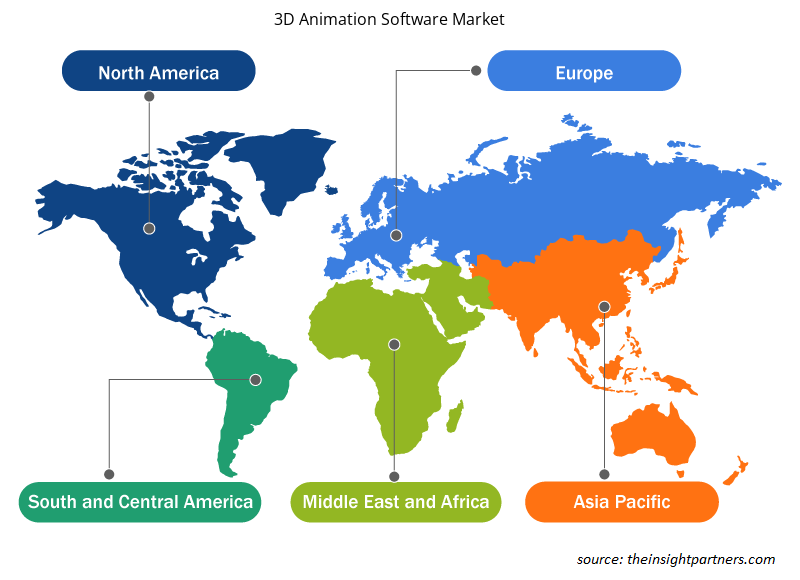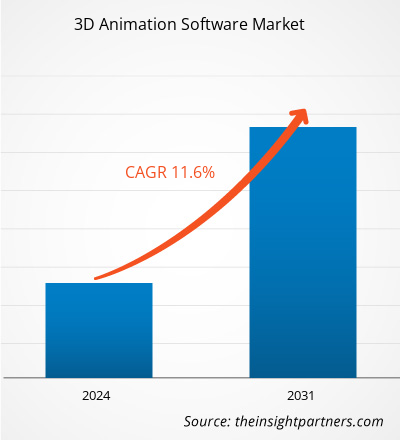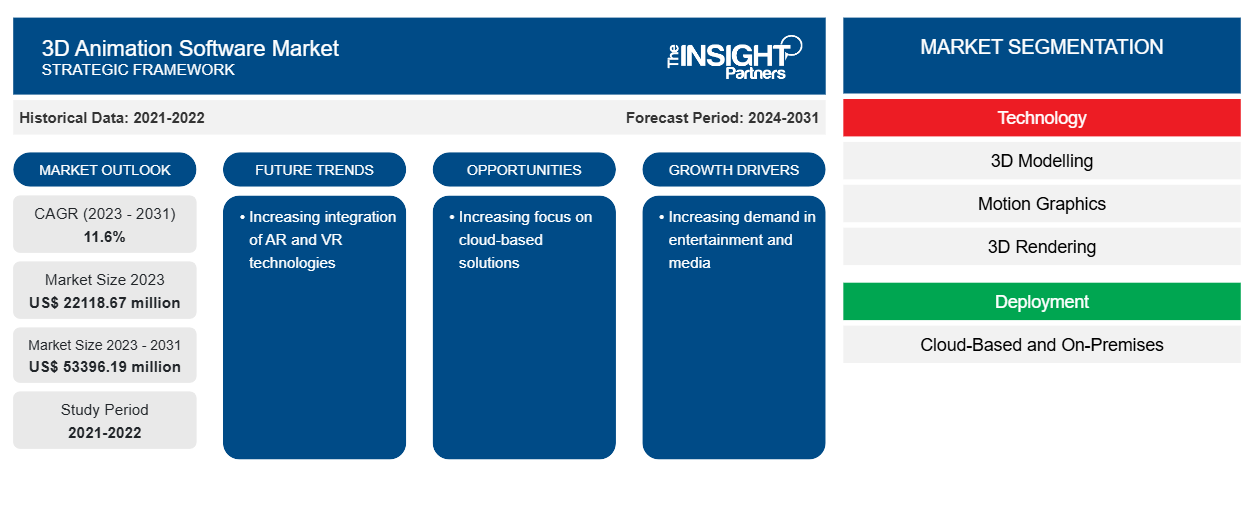Der Markt für 3D-Animationssoftware soll von 22.118,67 Millionen US-Dollar im Jahr 2023 auf 53.396,19 Millionen US-Dollar im Jahr 2031 anwachsen. Der Markt wird zwischen 2023 und 2031 voraussichtlich eine durchschnittliche jährliche Wachstumsrate (CAGR) von 11,6 % verzeichnen. Die zunehmende Integration von AR- und VR-Technologien dürfte ein wichtiger Trend auf dem Markt bleiben.
Marktanalyse für 3D-Animationssoftware
Zu den wichtigsten Wachstumsfaktoren für den Markt für 3D-Animationssoftware zählen der sich entwickelnde Trend zu virtueller Realität (VR) und künstlicher Intelligenz (KI) sowie die steigende Nachfrage nach 3D-Apps und -Spielen für Mobilgeräte. Darüber hinaus kurbeln bedeutende technologische Fortschritte und die zunehmende Nutzung von Animationssoftware für Bildungs- und akademische Zwecke das Wachstum des Marktes für 3D-Animationssoftware an. Der Marktbericht für 3D-Animationssoftware bietet eine detaillierte Untersuchung verschiedener treibender Faktoren und kommender Trends, die zur Verbreitung des Marktes für 3D-Animationssoftware beitragen.
Marktübersicht für 3D-Animationssoftware
3D-Animationssoftware ist ein Programm für computergenerierte Bilder (CGI) zum Anzeigen, Generieren und Ändern statischer und dynamischer 3D-Bilder und -Animationen. Durch zahlreiche Technologien wie visuelle Effekte (VFX), 3D-Modellierung , Bewegungsgrafiken und 3D-Rendering mischt das Programm Videomaterial und künstliche Bilder, um realistische Objekte und Situationen zu erstellen. Es wird häufig verwendet, um kreative Effekte in Markenwerbung und Produktwerbung zu erzeugen, wissenschaftliche, Produkt- und Systeminformationen zu visualisieren und visuelle Analysen durchzuführen. Es hat zahlreiche Anwendungen in Sektoren wie Medien und Unterhaltung, Architektur, Gesundheitswesen und Biowissenschaften.
Passen Sie diesen Bericht Ihren Anforderungen an
Sie erhalten kostenlose Anpassungen an jedem Bericht, einschließlich Teilen dieses Berichts oder einer Analyse auf Länderebene, eines Excel-Datenpakets sowie tolle Angebote und Rabatte für Start-ups und Universitäten.
-
Holen Sie sich die wichtigsten Markttrends aus diesem Bericht.Dieses KOSTENLOSE Beispiel umfasst eine Datenanalyse von Markttrends bis hin zu Schätzungen und Prognosen.
Treiber und Chancen auf dem Markt für 3D-Animationssoftware
Steigende Nachfrage in Unterhaltung und Medien
3D-Animationssoftware wird in der Spiele-, Film- sowie Medien- und Unterhaltungsbranche häufig als Standardsoftware für 3D-Animation eingesetzt. Diese Animationstools unterstützen sowohl polygonale als auch Sculpting-Workflows. Charakteranimation ist dank der Funktionen für Rigging und Keyframe-Animation eine ihrer wichtigsten Stärken. Sie unterstützt auch die Eingabe von Motion-Capturing-Software und ist daher bei Teams beliebt, die hochrealistische Bewegungen für Charaktere erfassen müssen. Daher steigt die Nachfrage nach solcher Software in der Unterhaltungs- und Medienbranche.
Zunehmender Fokus auf Cloud-basierte Lösungen
Verschiedene Unternehmen ergreifen strategische Initiativen, um cloudbasierte 3D-Animationssoftware auf den Markt zu bringen, wie etwa Partnerschaften, Übernahmen usw. So gab Autodesk, Inc. im Mai 2024 bekannt, dass es Wonder Dynamics übernommen hat, die Hersteller von Wonder Studio, einer cloudbasierten 3D-Animations- und VFX-Lösung, die künstliche Intelligenz (KI) mit etablierten Tools kombiniert. Ebenso brachte der in Australien ansässige VFX-Branchen- und Postproduktionsspezialist Andreas Wanda im April 2024 Atmos auf den Markt, ein neues cloudbasiertes VFX- und Animationsstudio, das vollständig ferngesteuerte Postproduktionslösungen für Rundfunkfilme, Fernsehen und Online-Inhalte anbietet. Somit schafft die zunehmende Verbreitung von Elektrofahrzeugen weitere Chancen für den Markt.
Segmentierungsanalyse des Marktberichts für 3D-Animationssoftware
Wichtige Segmente, die zur Ableitung der Marktanalyse für 3D-Animationssoftware beigetragen haben, sind Technologie, Bereitstellung und Anwendung.
- Basierend auf der Technologie ist der Markt für 3D-Animationssoftware in 3D-Modellierung, Bewegungsgrafiken, 3D-Rendering, visuelle Effekte (VFX) und andere unterteilt. Das Lösungssegment hatte im Jahr 2023 einen größeren Marktanteil.
- Nach Bereitstellung ist der Markt in Cloud-basiert und vor Ort segmentiert. Das Cloud-Segment hatte im Jahr 2023 einen größeren Marktanteil.
- Nach MA-Bewerbungsmaterial ist der Markt in Medien und Unterhaltung, Gesundheitswesen und Biowissenschaften, Fertigung, Bildung und Forschung und Sonstige unterteilt.
Marktanteilsanalyse für 3D-Animationssoftware nach geografischer Lage
Der geografische Umfang des Marktberichts für 3D-Animationssoftware ist hauptsächlich in fünf Regionen unterteilt: Nordamerika, Asien-Pazifik, Europa, Naher Osten und Afrika sowie Süd- und Mittelamerika.
Nordamerika hatte den größten Marktanteil bei 3D-Animationssoftware. Das Marktwachstum in dieser Region ist auf die zunehmende Nutzung modernster Technologien in den Bereichen Gesundheitswesen und Biowissenschaften, Medien und Unterhaltung sowie Bildung und Wissenschaft zurückzuführen. Die zunehmende Verwendung von visuellen Effekten in Filmen, mobilen Anwendungen und Spielen trägt zum Markt für 3D-Animationssoftware in Nordamerika bei.
Regionale Einblicke in den Markt für 3D-Animationssoftware
Die regionalen Trends und Faktoren, die den Markt für 3D-Animationssoftware im Prognosezeitraum beeinflussen, wurden von den Analysten von Insight Partners ausführlich erläutert. In diesem Abschnitt werden auch Marktsegmente und Geografie für 3D-Animationssoftware in Nordamerika, Europa, im asiatisch-pazifischen Raum, im Nahen Osten und Afrika sowie in Süd- und Mittelamerika erörtert.

- Holen Sie sich die regionalen Daten für den Markt für 3D-Animationssoftware
Umfang des Marktberichts zur 3D-Animationssoftware
| Berichtsattribut | Details |
|---|---|
| Marktgröße im Jahr 2023 | 22118,67 Millionen US-Dollar |
| Marktgröße bis 2031 | 53396,19 Millionen US-Dollar |
| Globale CAGR (2023 - 2031) | 11,6 % |
| Historische Daten | 2021-2022 |
| Prognosezeitraum | 2024–2031 |
| Abgedeckte Segmente |
Nach Technologie
|
| Abgedeckte Regionen und Länder |
Nordamerika
|
| Marktführer und wichtige Unternehmensprofile |
|
Marktdichte von 3D-Animationssoftware: Auswirkungen auf die Geschäftsdynamik verstehen
Der Markt für 3D-Animationssoftware wächst rasant, angetrieben durch die steigende Nachfrage der Endnutzer aufgrund von Faktoren wie sich entwickelnden Verbraucherpräferenzen, technologischen Fortschritten und einem größeren Bewusstsein für die Vorteile des Produkts. Mit steigender Nachfrage erweitern Unternehmen ihr Angebot, entwickeln Innovationen, um die Bedürfnisse der Verbraucher zu erfüllen, und nutzen neue Trends, was das Marktwachstum weiter ankurbelt.
Die Marktteilnehmerdichte bezieht sich auf die Verteilung der Firmen oder Unternehmen, die in einem bestimmten Markt oder einer bestimmten Branche tätig sind. Sie gibt an, wie viele Wettbewerber (Marktteilnehmer) in einem bestimmten Marktraum im Verhältnis zu seiner Größe oder seinem gesamten Marktwert präsent sind.
Die wichtigsten auf dem Markt für 3D-Animationssoftware tätigen Unternehmen sind:
- Adobe
- Autodesk Inc.
- Corel Corporation
- EIAS3D
- Maxon Corporation GmbH
- Seiteneffekt
Haftungsausschluss : Die oben aufgeführten Unternehmen sind nicht in einer bestimmten Reihenfolge aufgeführt.

- Überblick über die wichtigsten Akteure auf dem Markt für 3D-Animationssoftware
Neuigkeiten und aktuelle Entwicklungen zum Markt für 3D-Animationssoftware
Der Markt für 3D-Animationssoftware wird durch die Erfassung qualitativer und quantitativer Daten nach Primär- und Sekundärforschung bewertet, die wichtige Unternehmensveröffentlichungen, Verbandsdaten und Datenbanken umfasst. Nachfolgend sind einige der Entwicklungen auf dem Markt für 3D-Animationssoftware aufgeführt:
- DeepMotion, ein langjähriger Marktführer im Bereich KI-gestützter Motion-Capture-Technologie, kündigt MotionGPT™ an, ein bahnbrechendes Tool, das die Leistungsfähigkeit generativer KI nutzt, um Textaufforderungen in komplexe 3D-Animationen umzuwandeln. MotionGPT vereinfacht nicht nur den Erstellungsprozess von Animationen weiter, sondern überwindet auch physische Barrieren und ermöglicht einem vielfältigeren Publikum von Entwicklern und Branchen mühelose, kostengünstige 3D-Animationen. (Quelle: DeepMotion, Pressemitteilung, September 2023)
- Kinetix, ein Deep-Tech-Start-up und Pionier der KI-gestützten 3D-Animation, hat seine Bibliothek an 3D-Assets durch die Zusammenarbeit mit Adobe erweitert. Mit seiner einzigartigen No-Code-Technologie können animierte 3D-Figuren automatisch und sofort aus einem einfachen 2D-Video generiert werden. Diese wird nun durch eine beispiellose Auswahl an Mixamo-Animationen und -Figuren des Softwareherstellers erweitert. Diese Zusammenarbeit bringt das französische Start-up seinem Ziel, animiertes und sofortiges 3D einer möglichst großen Zahl von Entwicklern zugänglich zu machen, seien es Profis oder Amateure, einen Schritt näher. (Quelle: Kinetix, Pressemitteilung, März 2022)
Marktbericht zu 3D-Animationssoftware – Abdeckung und Ergebnisse
Der Bericht „Marktgröße und Prognose für 3D-Animationssoftware (2021–2031)“ bietet eine detaillierte Analyse des Marktes, die die folgenden Bereiche abdeckt:
- Marktgröße und Prognose für 3D-Animationssoftware auf globaler, regionaler und Länderebene für alle wichtigen Marktsegmente, die im Rahmen des Berichts abgedeckt sind
- Markttrends für 3D-Animationssoftware sowie Marktdynamik wie Treiber, Einschränkungen und wichtige Chancen
- Detaillierte PEST/Porters Five Forces- und SWOT-Analyse
- Marktanalyse für 3D-Animationssoftware mit wichtigen Markttrends, globalen und regionalen Rahmenbedingungen, wichtigen Akteuren, Vorschriften und aktuellen Marktentwicklungen
- Branchenlandschaft und Wettbewerbsanalyse, einschließlich Marktkonzentration, Heatmap-Analyse, prominenten Akteuren und aktuellen Entwicklungen auf dem Markt für 3D-Animationssoftware
- Detaillierte Firmenprofile
- Historische Analyse (2 Jahre), Basisjahr, Prognose (7 Jahre) mit CAGR
- PEST- und SWOT-Analyse
- Marktgröße Wert/Volumen – Global, Regional, Land
- Branchen- und Wettbewerbslandschaft
- Excel-Datensatz
Aktuelle Berichte
Verwandte Berichte
Erfahrungsberichte
Grund zum Kauf
- Fundierte Entscheidungsfindung
- Marktdynamik verstehen
- Wettbewerbsanalyse
- Kundeneinblicke
- Marktprognosen
- Risikominimierung
- Strategische Planung
- Investitionsbegründung
- Identifizierung neuer Märkte
- Verbesserung von Marketingstrategien
- Steigerung der Betriebseffizienz
- Anpassung an regulatorische Trends























 Kostenlose Probe anfordern für - Markt für 3D-Animationssoftware
Kostenlose Probe anfordern für - Markt für 3D-Animationssoftware